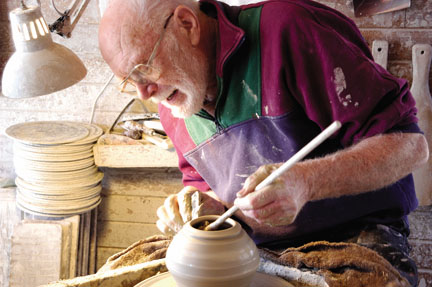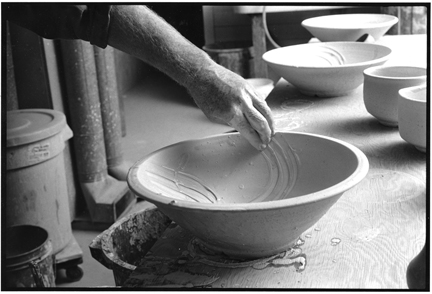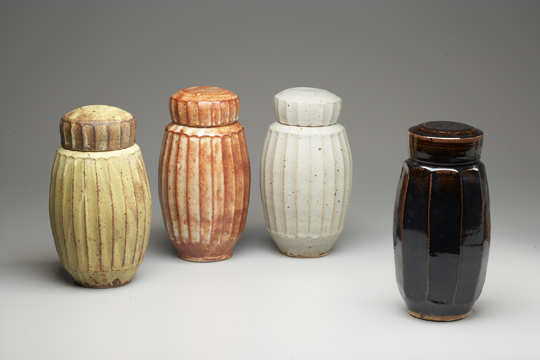Warren MacKenzie, In His Own Words
Read Mason Riddles interview with Warren MacKenzie, mingei potter and American original, here; and read her review of his retrospective at the Rochester Art Center elsewhere in this issue.



How would you describe the current climate of ceramic arts in the Twin Cities and in Minnesota?
It is very strong with all sorts of clay expressions. Personally, I think, outside of the Midwest, it is not so well known. In part this is because we do not have many people who are doing something – something more groundbreaking or breaking down barriers. However, we do have all forms of ceramics – simple pots, sculpture and more experimental work. But, few are gathering national attention as I see it. We do have extremely good artists, who are able to make a living and that is something. This lack of recognition [for pottery] is due, in part, to the fact that major museums have paid little attention to the so-called craft arts, until recently. When Alix and I first moved to Minnesota, Walker Art Center was interested in the fine arts, design, architecture and the craft arts. This has changed. [Walker showed MacKenzie in 1948, 1954, and 1961]. These activities, the craft arts, still, have the image of being a minor art with many museums.
Are there other communities or centers of ceramics or pottery that you see as influential, or important, like the Archie Bray Foundation?
For me, it is as important to talk about and understand the way something is made as what is actually being made. Historic centers of pottery-making such as Appalachia are stronger, in many ways, than those in New York City, San Francisco, or Los Angeles. Some very strong statements have been made over the decades by Appalachian craftsmen. The Northern Clay Center is a strong center but doesn’t always generate the same kind of interest as Archie Bray once did with the likes of Peter Voulkos and Rudy Autio. Archie Bray ran a brickyard and turned it into this center for ceramics. And Voulkos changed forever the way people looked at ceramics. There is not much like that now. We don’t have that here. It doesn’t really happen at Penland or Haystack. I was not an innovative potter; I was a traditional potter.
What is the best way to learn about ceramics, about pots?
It is important to go to a strong school that promotes and develops the ceramic arts. What strikes me is that in many areas of the country strong craft activity often centers on a strong program at a university. That happened here in Minnesota and many of the students stayed and have continued their work, and are making a living by it. Clay is really the only one of the craft arts (taught at the university) that has caught on as a localized activity. In the late 1940s – 1950s there was a wonderful jeweler who taught at the University, Phillip Morton. He had a lot to say with his jewelry. But that has all faded. Once there was a weaving program in the art department that had great excitement for a while but that too is gone. And glass faded in the late 1980s. My approach to teaching ceramics was not the most popular, or strongest in the development of the ceramics at that time. My approach was conservative.
How do you see the state of ceramic arts growing today?
Craft involvement has almost always centered around an individual. Peter Voulkos and Rudy Autio developed a great following at Archie Bray. Like the fine arts, it is just as easy to produce crap as it is good work in the craft arts. Many, many students studied with me, maybe too many. There are those who have broken away, like Mark Pharis, and those who remain close to the type of work I make, like Randy Johnston. Wayne Branum has become a very good architect, but still makes wonderful pots. Maren Kloppman was never my student, but she has established quite a following for her work. So has Bob Briscoe, who never studied with me either.
What museum collections of pots should one see?
There is not a better place to see pots, really, than in anthropological museums around the country. They don’t have a strict idea about what is and is not art, like some art museums. They are not so oriented to fashion. There is the Field Museum in Chicago, the Natural History Museum in New York City, and the Smithsonian in D.C. These places look at the history of clay. The Minneapolis Institute of Arts has a tremendous variety of clay expressions, but they are found in specific collections of Asian, African, or South American art. Not a collection of ceramic art. Too often our museums show the clay of other countries, but not very much of our own. It is just wonderful to stumble upon collections of clay in museums when traveling in other countries.
Could you speak to the influences on your work?
The first influence was when Alix and I apprenticed at Bernard Leach’s pottery in St. Ives, England. Because we stayed in his house, we were around his collection of pots. We saw pots from China and Japan. It is also where we met Shoji Hamada, the master Japanese potter who worked in the mingei tradition. Through Leach and his book, The Potter’s Book, pottery became more available. Hamada, who was influenced by Korean folk pottery, took a tradition and gave it new life. I gravitated to his philosophy and how he threw pots. It was a philosophy of “don’t look at my work, but look at the influences of my work. These influences are stronger [than my pots] as they represent a culture.” Koreans didn’t have a word for “good or bad”, just mu, “it is.” Hamada’s work had tremendous breadth – it was an attitude – carried out as well as possible.
What do you like about Asian pots?
I like the historic pots of China and Japan and Korea, where the culture was more elemental, when these pots were beginning to be made. Much of contemporary Japanese pottery has become all too clever but fantastic in terms of technical skill. The potters have gained incredible skills, but they have lost an emotional reason to express. But, this is only my personal opinion.
Are there any other influences you would like to mention?
You can’t change your life and your aesthetic because of everyone and everything you come in contact with, even though you may admire it. Some things affect you more strongly than others. I love American Indian pottery, but it hasn’t really influenced my work. All my work has been done on a kick-wheel. As Tim Crane [a ceramic artist and early student of MacKenzie’s] said, “You chose to be a potter with a wheel.” Of course, Tim is fascinated by slabs of clay; nothing else will do.